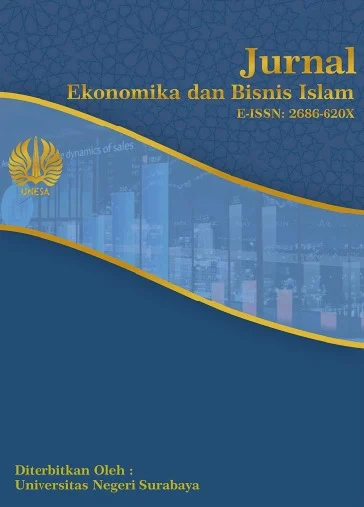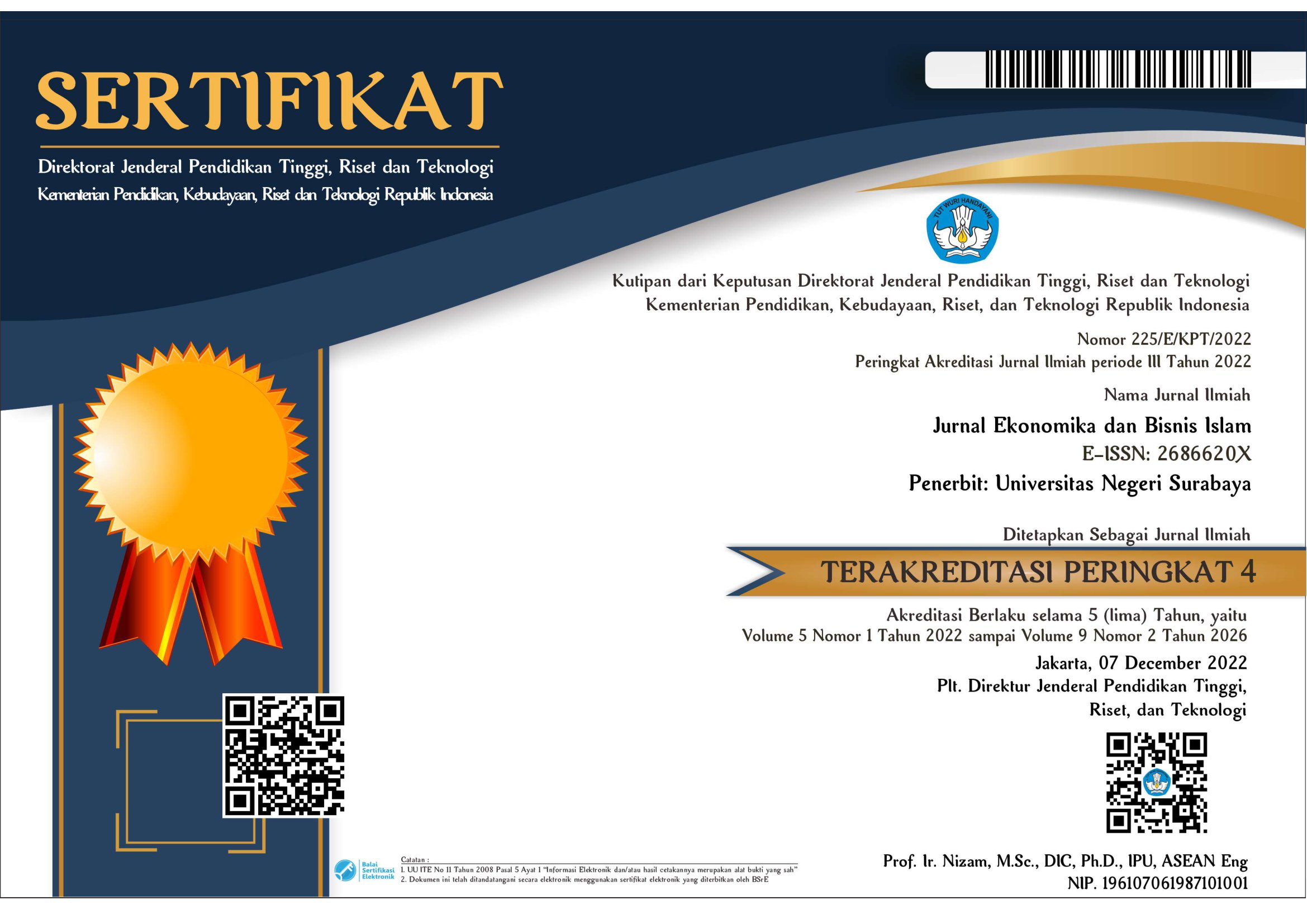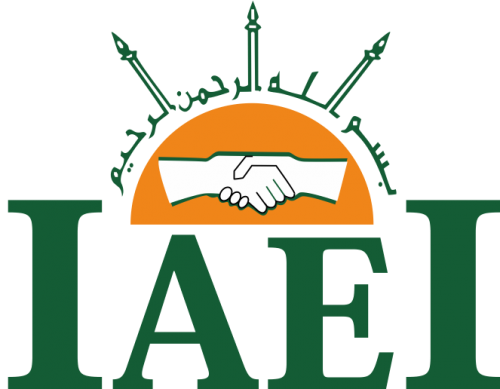Switching Intention Nasabah Bank Konvensional ke Bank Syariah: Studi Kasus Mahasiswa Ekonomi Islam di Surabaya
DOI:
https://doi.org/10.26740/jekobi.v8n2.p36-56Keywords:
Switching Intention, Sharia Banking, Price Perception, Sharia Financial Literacy, Islamic Economic StudentAbstract
The development of Islamic banking in Indonesia shows a positive trend, yet its market share still lags behind conventional banks. This study aims to analyze the factors that influence Islamic Economics students in Surabaya to switch from conventional to Islamic banks. The Push-Pull-Mooring (PPM) framework was employed, covering push factors (price perception, service quality, satisfaction), pull factors (alternative attractiveness), and mooring factors (Islamic financial literacy, religiosity, subjective norms). A quantitative method was applied using Partial Least Square-Structural Equation Modeling (PLS-SEM) with SmartPLS 4 software, involving 162 respondents from three public universities in Surabaya. The results reveal that all push, pull, and mooring variables have a positive and significant influence on switching intention. These findings highlight the role of financial literacy and religious values in motivating the shift toward Islamic financial services among young Muslim generations. This research offers practical implications for Islamic bank marketing strategies to enhance service attractiveness and expand into academic markets.
References
Ajzen, I. (2001). Perceived Behavioral Control, Self-efficacy, Locus of Control, and The Theory of Planned Behavior. Journal of Applied Social Psychology, 32(4), 665–683.
Ajzen, I., & Fishbein, M. (1980). Understanding Attitudes and Predicting Social Behavior. Prentice-Hall.
Alifandi, T., & Fasa, M. I. (2024). Analysis of the Influence of Banking Digitalization on Customer Satisfaction in Using BSI Bank in Bandar Lampung. JICN: Jurnal Intelek Dan Cendikiawan Nusantara, 1(5), 7306–7314.
Bansal, H. S., Taylor, S. F., & St. James, Y. (2005). Migrating to New Service Providers: Toward a Unifying Framework of Consumers’ Switching Behaviors. Journal of the Academy of Marketing Science, 33(1), 96–115.
Baskara, A. L. (2025). Kualitas Layanan dan Kepuasan Pelanggan Terhadap Switching Intention Rumah Kost. Jurnal Riset Mahasiswa Ekonomi (RITMIK), 7(2), 200–208.
Chatters, L. M. (2000). Religion and health: public health research and practice. 21:335-367. https://doi.org/https://doi.org/10.1146/annurev.publhealth.21.1.335
Djusmin, V., & Dirgahayu, R. T. (2019). Push Pull Mooring dan Pyschological Ownership terhadap Perilaku Beralih Pengguna Instant Messaging. Indonesian Journal of Information Systems, 2(1), 1–12. https://doi.org/10.24002/ijis.v2i1.2013
Firdausi, A. S. M., & Dharmmesta, B. S. (2023). The Effect of Push, Pull, and Mooring Factors on Customers’ Switching Intention to Green Cosmetics. Gadjah Mada International Journal of Business, 25(3), 327–354. https://doi.org/10.22146/gamaijb.69863
Firdiyanti, S. I., Abdillah, M., Prasetyoningrum, A. K., & Fuadi, N. F. Z. (2022). Competition in Business: Analysis of Factors Affecting Customers Switching Intention of Conventional Banks To Islamic Banks in Central Java. Jurnal Alwatzikhoebillah : Kajian Islam, Pendidikan, Ekonomi, Humaniora, 8(2), 274–290. https://doi.org/10.37567/alwatzikhoebillah.v8i2.1992
Ghozali, I. (2013). Aplikasi Analisis Multivariate Dengan Program IBM SPSS 21 Update PLS Regresi. Badan Penerbit Universitas Diponegoro.
Ghozali, I., & M.Latan, H. (2015). Partial Least Squares : Konsep, Teknik dan Aplikasi Menggunakan Program SmartPLS 3.0 Ed.2. Badan Penerbit Universitas Diponegoro.
Hair, Joseph F.; Black, William C.; Babin, Barry J.; Anderson, R. E. (2014). Multivariate Data Analysis. https://doi.org/10.4324/9781351269360
Hair, J. F., Risher, J. J., Sarstedt, M., & Ringle, C. M. (2019). When to use and how to report the results of PLS-SEM. European Business Review, 31(1), 2–24. https://doi.org/10.1108/EBR-11-2018-0203
Hair, J., Hult, G. T. M., Ringle, C., & Sarstedt, M. (2022). A Primer on Partial Least Squares Structural Equation Modeling (PLS-SEM).
Hati, S. R. H., Gayatri, G., & Indraswari, K. D. (2021). Migration (Hijra) to Islamic bank based on push–pull–mooring theory: a services marketing mix perspective. Journal of Islamic Marketing, 12(8), 1637–1662. https://doi.org/10.1108/JIMA-07-2019-0157
Henseler, J., Ringle, C. M., & Sarstedt, M. (2015). A new criterion for assessing discriminant validity in variance-based structural equation modeling. Journal of the Academy of Marketing Science. Journal of the Academy of Marketing Science, 43, 115–135. https://doi.org/10.1007/s11747-014-0403-8
Hermawan, S., & Amirullah, A. (2016). Metode Penelitian Bisnis Pendekatan Kuantitatif & Kualitatif.
Ismet, R. A., & Patrisia, D. (2025). The Influence Of Perceived Value, Customer Trust, And Price On Switching Intention Through Customer Satisfaction In Online Transportation Services: A Case Study Of Maxim Application Among Generation Z In Padang City. SANTHET: (Jurnal Sejarah, Pendidikan Dan Humaniora), 9(1), 369–376.
Khoirunnisa, H. F. (2021). Pengaruh persepsi harga terhadap keputusan pembelian ultra cover bb cream maybelline pada watsonss ciplaz karawang. Pengaruh Persepsi Harga Terhadap Keputusan Pembelian Produk Kosmetik Maybeline Di Watsons Ciplaz Karawang, 368.
Kotler, P., & Keller, K. L. (2017). Manajemen Pemasaran. Erlangga.
Lestari, D. I. P., Cahyaningtyas, S. R., & Isnaini, Z. (2023). Pengaruh Literasi Keuangan Syariah, Pengetahuan, Religiusitas, dan Uang Saku terhadap Minat Mahasiswa Menjadi Nasabah pada Bank Syariah (Studi Kasus pada Mahasiswa Fakultas Ekonomi dan Bisnis Universitas Mataram). Jurnal Risma, 3(3), 68–82.
Lubis, Y. A., & Rokan, M. K. (2021). Analisis Faktor-Faktor yang Mempengaruhi Switching Intention pada Bank Syariah Kc Lubuk Pakam. 1(03), 188–193.
Lupiyoadi, R. (2014). Manajemen Pemasaran Jasa. Salemba Empat.
Maureen Nelloh, L. A., & Purwanto Liem, C. C. (2012). Analisis Switching Intention Pengguna Jasa Layanan Rumah Kos Di Siwalankerto: Perspektif Kualitas Layanan Dan Kepuasan Pelanggan. Jurnal Manajemen Pemasaran, 6(1), 22–31. https://doi.org/10.9744/pemasaran.6.1.22-31
Monoarfa, H., Al Adawiyah, R. A., Prananta, W., Sadat, A. M., & Vakhroh, D. A. (2024). Switching intention of conventional bank customers to Sharia bank based on push-pull-mooring theory. Journal of Islamic Marketing, 15(8), 2104–2121. https://doi.org/10.1108/JIMA-08-2022-0220
Nurhasanah, S. (2017). Praktikum Statistika 2 Untuk Ekonomi dan Bisnis Aplikasi dengan Ms Excel dan SPSS (2nd ed.). Salemba Empat.
Otoritas Jasa Keuangan. (2017). Surat Edaran Otoritas Jasa Keuangan Nomor 30/SEOJK.07/2017 tentang Pelaksanaan Kegiatan dalam Rangka Meningkatkan Literasi Keuangan di Sektor Jasa Keuangan. In Surat Edaran Otoritas Jasa Keuangan Nomor 30 /Seojk.07/2017.
Otoritas Jasa Keuangan. (2024). Statistik Perkembangan Bank Syariah (Issue July).
Otoritas Jasa Keuangan dan Badan Pusat Statistik. (2024). Survei Nasional Literasi dan Inklusi Keuangan (SNLIK).
Parasuraman, A., Zeithaml, V. A., & Berry, L. L. (2013). Model SERVQUAL: A Multi-Item Scale for Measuring Consumer Perceptions of Service Quality.
Pasi, I. R. (2019). Pengaruh pengetahuan dan sikap terhadap perilaku masyarakat pada bank syariah. Jurnal Al-Qasd Islamic Economic Alternative, 1(2), 189–201.
Pradana, A. P., Lestari, B., Niaga, A., Malang, P. N., Referensil, K., Pembelian, K., Group, R., & Decision, B. (2021). Pengaruh gaya hidup dan kelompok referensi terhadap keputusan pembelian konsumen kopi chuseyo malang. 29–32.
Rahim, Rashid, & Hamed. (2016). Islamic Financial Literacy and its Determinants among University Students : An Exploratory Factor Analysis. International Journal of Economics and Financial Issues, 6(S7), 32–35.
Rivai, J., & Zulfitri. (2021). The Role of Purchasing Decisions Mediating Product Quality, Price Perception, and Brand Image on Customer Satisfaction of Kopi Janji Jiwa. Journal of Business and Management Studies, 3(2), 31–42.
Shmueli, G., Hair, J. F., Ting, H., & Ringle, C. M. (2019). Predictive model assessment in PLS-SEM : guidelines for using PLSpredict. 53(11), 2322–2347. https://doi.org/10.1108/EJM-02-2019-0189
Suhadah. (2023). Pengaruh Literasi Keuangan Syariah dan Religiusitas terhadap Keputusan Nasabah Menabung di Bank Syariah Indonesia ( Studi pada Nasabah Bsi Kc Solo Slamet Riyadi 1 ).
Tjiptono, F. (2015). Strategi Pemasaran. Edisi 4. Andi Offset.
Vinasti, I. S. (2022). Peran Mahasiswa Fakultas Ekonomi dan Bisnis Islam dalam Sosialisasi Perbankan Syariah.
Wijaya, A. F. (2024). Pengaruh Atribut Produk dan Persepsi Harga terhadap Perpindahan Merek Pengguna Jaringan Operator Telkomsel ke Operator Lain (Studi pada Mahasiswa Universitas Brawijaya di Kota Malang).
Wong, K. K.-K. (2013). Partial least square structural equation modeling (PLS-SEM) techniques using SmartPLS. Marketing Bulletin, 24, 1–32.
Yudhistira, P. A. (2021). Analisis Efek Moderasi: Involvement, Switching Cost, dan Alternative Attractiveness dalam Hubungan antara Niat Perpindahan Konsumen dan Performa Buruk Perusahaan.
Yusfiarto, R., Sunarsih, S., & Darmawan, D. (2021a). Understanding Muslim’s switching from cash to m-payments: based on push-pull-mooring framework. Journal of Islamic Marketing, 14(2), 342–365. https://doi.org/10.1108/JIMA-05-2021-0135
Yusfiarto, R., Sunarsih, S., & Darmawan, D. (2021b). Understanding Muslim ’ s switching from cash to m-payments : based on push-pull-mooring framework. 342–365. https://doi.org/10.1108/JIMA-05-2021-0135
Downloads
Published
How to Cite
Issue
Section
License
Copyright (c) 2025 Fata Habibullah, Clarashinta Canggih

This work is licensed under a Creative Commons Attribution 4.0 International License.
This work is licensed under a Creative Commons Attribution 4.0 International License.
 Abstract views: 89
,
Abstract views: 89
, PDF Downloads: 74
PDF Downloads: 74














